Chapter 2 The Writing Process

What is the writing process?
The writing process is a step-by-step approach to any writing, whether it is for academic essays or on-the-job projects. Following a process has many benefits, from overcoming writer’s block to organizing ideas on a page. So, take a deep breath, and take it one step at a time.
The Writing Process—How Do I Begin?
If you think that a blank sheet of paper or a blinking cursor on the computer screen is a scary sight, you are not alone. Many writers, students, and employees find that beginning to write can be intimidating. When faced with a blank page, however, experienced writers remind themselves that writing, like other everyday activities, is a process. Every process, from writing to cooking, bike riding, and learning to use a new cell phone, will get significantly easier with practice.
Just as you need a recipe, ingredients, and proper tools to cook a delicious meal, you also need a plan, resources, and adequate time to create a good written composition. In other words, writing is a process that requires following steps and using strategies to accomplish your goals.
These are the five steps in the writing process:
- Prewriting
- Outlining the structure of ideas
- Writing a rough draft
- Revising
- Editing
Effective writing can be simply described as good ideas that are expressed well and arranged in the proper order. This chapter will give you the chance to work on all these important aspects of writing.
Using the strategies in this chapter can help you overcome the fear of the blank page and confidently begin the writing process.
Prewriting 
Prewriting is the stage of the writing process during which you transfer your abstract thoughts into more concrete ideas in ink on paper or in type on a computer screen. Although prewriting techniques can be helpful in all stages of the writing process, the following four strategies are best used when initially deciding on a topic:
- Using experience and observations
- Reading
- Freewriting
- Asking questions
At this stage in the writing process, it is OK if you choose a general topic. Later you will learn more prewriting strategies that will narrow the focus of the topic.
Choosing a Topic
In addition to understanding that writing is a process, writers also understand that choosing a good general topic for an assignment is an essential step. Sometimes your instructor will give you an idea to begin an assignment, and other times your instructor will ask you to come up with a topic on your own. A good topic not only covers what an assignment will be about but also fits the assignment’s purpose and its audience.
The first important step is for you to tell yourself why you are writing (to inform, to explain, to entertain, to compare, to evaluate, or some other purpose) and for whom you are writing.
Using Experience and Observations
When selecting a topic, you may also want to consider something that interests you or something based on your own life and personal experiences. Everyday observations can also lead to interesting topics. Even if an instructor gives you a detailed prompt, finding connections to your own life can lead to an engaging focus for an essay. After writers think about their experiences and observations, they often take notes on paper to better develop their thoughts. These notes help writers discover what they have to say about their topic.
Tip
Have you seen an attention-grabbing story on social media or the news? Many current issues appear on television, in magazines, and on the Internet. These can all provide inspiration for your writing.
Reading
Reading plays a vital role in all the stages of the writing process, but it first figures in the development of ideas and topics. Different kinds of documents can help you choose a topic and also develop that topic. For example, a social media post on the latest research about the threat of climate change may catch your eye while you scroll. This subject may interest you, and you may consider climate change as a topic. Or maybe a novel’s courtroom drama sparks your curiosity of a particular lawsuit or legal controversy.
After you choose a topic, critical reading is essential to the development of a topic. While reading almost any document, you evaluate the author’s point of view by thinking about their main idea and support. When you judge the author’s argument, you discover more about not only the author’s opinion but also your own. If this step already seems daunting, remember that even the best writers need to use prewriting strategies to generate ideas.
Tip
The steps in the writing process may seem time-consuming at first, but following these steps will save you time in the future. The more you plan in the beginning by reading and using prewriting strategies, the less time you may spend writing and editing later because your ideas will develop more swiftly.
Prewriting strategies depend on your critical reading skills. Reading prewriting exercises (and outlines and drafts later in the writing process) will further develop your topic and ideas.
Freewriting
Freewriting is an exercise in which you write freely about any topic for a set amount of time (usually three to five minutes). During the time limit, you may jot down any thoughts that come to your mind. Try not to worry about grammar, spelling, or punctuation. Instead, write as quickly as you can without stopping. If you get stuck, just copy the same word or phrase over and over until you come up with a new thought.
Writing often comes easier when you have a personal connection with the topic you have chosen. Remember, to generate ideas in your freewriting, you may also think about readings that you have enjoyed or that have challenged your thinking. Doing this may lead your thoughts in interesting directions.
Quickly recording your thoughts on paper will help you discover what you have to say about a topic. When writing quickly, try not to doubt or question your ideas. Allow yourself to write freely and unselfconsciously. Once you start writing with few limitations, you may find you have more to say than you first realized. Your flow of thoughts can lead you to discover even more ideas about the topic.
Freewriting may even lead you to discover another topic that excites you even more.
Look at the below example. The instructor allowed the members of the class to choose their own topics, and the student thought about their experiences as a communications major. They used this freewriting exercise to help them generate more concrete ideas from their own experience.
Tip
Some prewriting strategies can be used together. For example, you could use experience and observations to come up with a topic related to your course studies. Then you could use freewriting to describe your topic in more detail and figure out what you have to say about it.
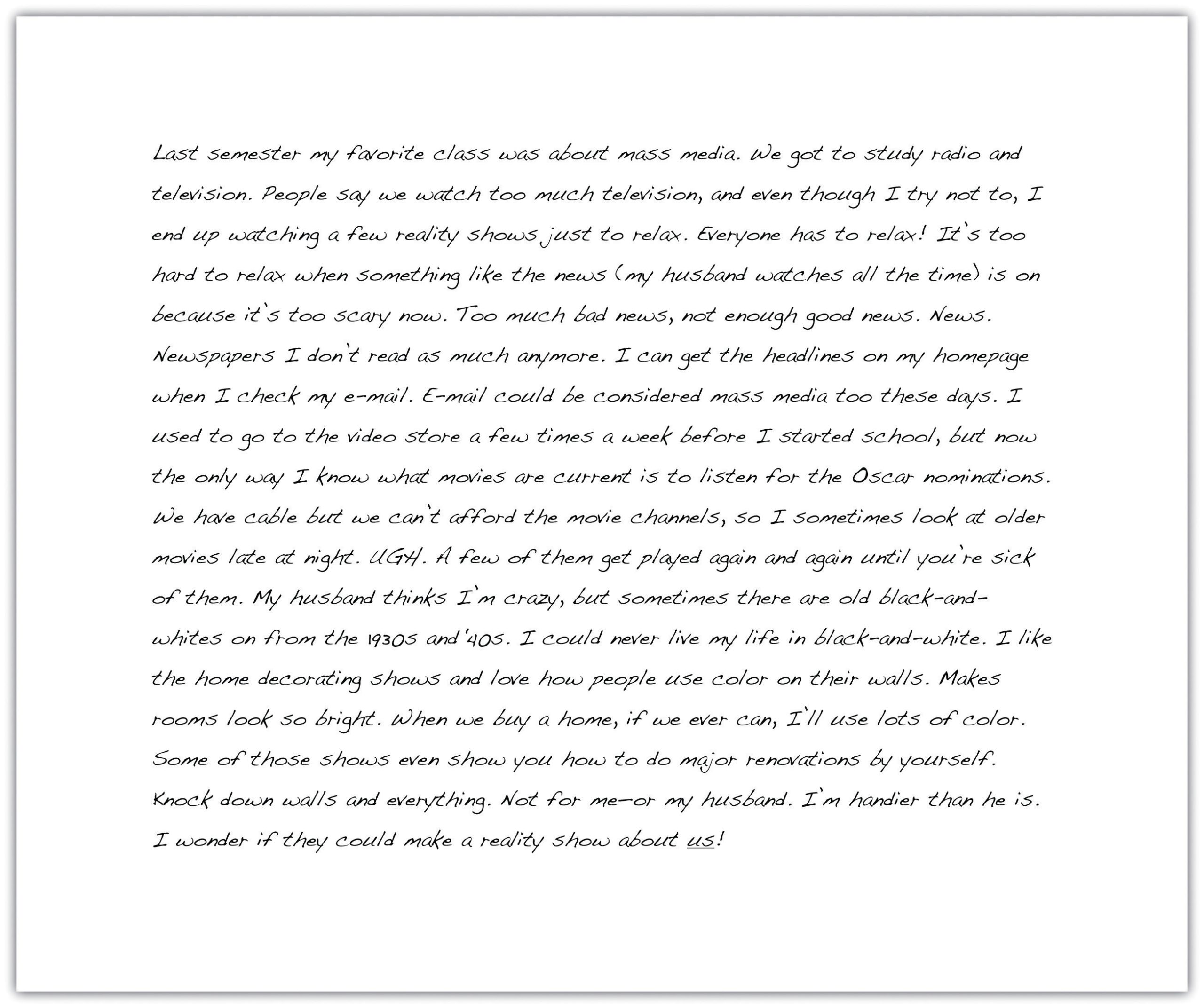
Exercise 2.1
Freewrite about one event you have recently experienced. With this event in mind, write without stopping for five minutes. After you finish, read over what you wrote. Does anything stand out to you as a good general topic to write about?
Asking Questions
 Who? What? Where? When? Why? How? In everyday situations, you pose these kinds of questions to get more information. Who will be my partner for the project? When is the next meeting? Why is my car making that odd noise? Even the beginning of this chapter asks the question, “How do I begin?”
Who? What? Where? When? Why? How? In everyday situations, you pose these kinds of questions to get more information. Who will be my partner for the project? When is the next meeting? Why is my car making that odd noise? Even the beginning of this chapter asks the question, “How do I begin?”
You seek the answers to these questions to gain knowledge, to better understand your daily experiences, and to plan for the future. Asking these types of questions will also help you with the writing process. As you choose your topic, answering these questions can help you revisit the ideas you already have and generate new ways to think about your topic. You may also discover aspects of the topic that are unfamiliar to you and that you would like to learn more about. All these idea-gathering techniques will help you plan for future work on your assignment.
When the student reread their freewriting notes, they found they had rambled, and the thoughts were disjointed. They realized that the topic that interested them most was the one they started with, the media. The student then decided to explore that topic by asking questions about it. Their purpose was to refine the media into a topic they felt comfortable writing about. To see how asking questions can help you choose a topic, take a look at the following chart that the student completed to record their questions and answers. They asked themself the questions that reporters and journalists use to gather information for their stories. The questions are often called the 5WH questions, after their initial letters.
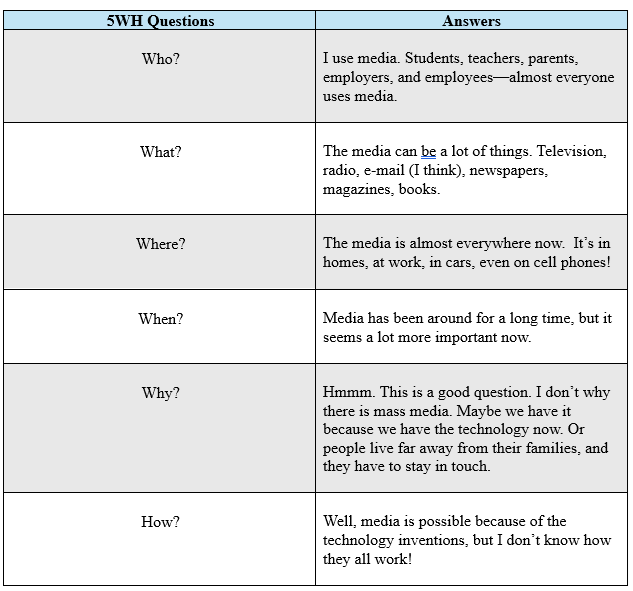
Tip
Prewriting is very purpose driven; it does not follow a set of hard-and-fast rules. The purpose of prewriting is to find and explore ideas so that you will be prepared to write. A prewriting technique like asking questions can help you both find a topic and explore it. The key to effective prewriting is to use the techniques that work best for your thinking process.
Freewriting may not seem to fit your thinking process but keep an open mind. It may work better than you think. Perhaps brainstorming a list of topics might better fit your personal style. In your own prewriting, use the 5WH questions in any way that benefits your planning.
Exercise 2.2
Choose a general topic idea from the prewriting you completed in Exercise 2.1. Then read each question and use your own paper to answer the 5WH questions. It is okay if you do not know all the answers. If you do not know an answer, use your own opinion to speculate, or guess. You may also use factual information from books or articles you previously read on your topic. Later in the chapter, you will read about additional ways (like searching the Internet) to answer your questions and explore your guesses.
5WH Questions
- Who?
- What?
- Where?
- When?
- Why?
- How?
Now that you have completed some of the prewriting exercises, you may feel less anxious about starting a paper from scratch. With some ideas down on paper or typed on a computer, writers are often more comfortable continuing the writing process. After identifying a good general topic, you, too, are ready to continue the process.
Exercise 2.3
Write your purpose for writing and the audience to whom you are writing on your own sheet of paper. Then, under where you recorded your purpose and audience, record your general topic. Choose it from among the topics you listed or explored during the prewriting you have done so far. Make sure it is one you feel comfortable with and feel capable of writing about.
My general topic:
Tip
You may find that you need to adjust your topic as you move through the writing stages (and as you complete the exercises in this chapter). If the topic you have chosen is not working, you can repeat the prewriting activities until you find a better one.
More Prewriting Techniques
The prewriting techniques of freewriting and asking questions help students to think more about their topics, but the following prewriting strategies can help you narrow the focus of the topic:
- Brainstorming
- Idea mapping
- Searching the Internet
Narrowing the Focus
Narrowing the focus means breaking up the topic into subtopics, or more specific points. Generating lots of subtopics will help you eventually select the ones that fit the assignment and appeal to you and your audience.
After rereading a prompt, a student may realize that a general topic is too broad for the class’s short paper requirement. For example, the student who prewrote about mass media realized that a few pages are not enough to cover all the concerns in mass media today. The student also realized that although that they could narrow their topic down to a particular issue in mass media.
Brainstorming
Brainstorming is similar to list making. You can make a list on your own or in a group with your classmates. Start with a blank sheet of paper or a blank computer document and write your general topic across the top. Underneath your topic, make a list of more specific ideas. Think of your general topic as a broad category and the list items as things that fit in that category. Often you will find that one item can lead to the next, creating a flow of ideas that can help you narrow your focus to a more specific paper topic.
Brainstorming works well for students who are left-brain dominant and think linearly.
Look at the below brainstorming list for mass media:
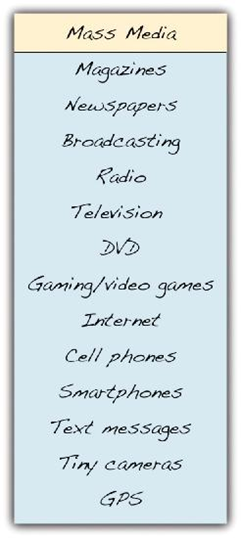
From this list, the student could narrow their focus to a particular technology under the broad category of mass media.
Idea Mapping
Idea mapping allows you to visualize your ideas on paper using circles, lines, and arrows. This technique is also known as clustering or bubbling because ideas are broken down and clustered or grouped together. Many writers—especially those who are visual learners or right-brain dominant—like this method because the shapes show how the ideas relate or connect, and writers can find a focused topic from the connections mapped. Using idea mapping, you might discover interesting connections between topics that you had not thought of before.
To create an idea map, start with your general topic in a circle in the center of a blank sheet of paper. Then write specific ideas around it and use lines or arrows to connect them together. Add and cluster as many ideas as you can think of.
Review the following idea map that the student created related to mass media:
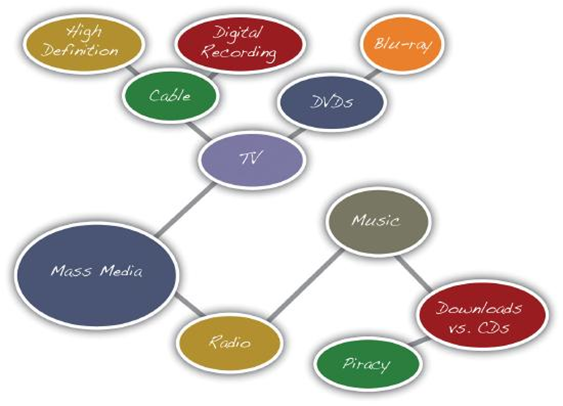
From this idea map, the student saw they could consider narrowing the focus of their mass media topic to the more specific topic of music piracy.
Searching the Internet
Using search engines on the Internet is a good way to see what kinds of websites are available on your topic. Writers use search engines not only to understand more about the topic’s specific issues but also to get better acquainted with their audience.
When you search the Internet, type some key words from your broad topic or words from your narrowed focus into your browser’s search engine (many good general and specialized search engines are available for you to try). Then look over the results for relevant and interesting articles.
Results from an Internet search show writers the following information:
- Who is talking about the topic
- How the topic is being discussed
- What specific points are currently being discussed about the topic
Tip
If the search engine results are not what you are looking for, revise your key words and search again. Some search engines also offer suggestions for related searches that may give you better results.
The student typed the words music piracy from their idea map into the search engine Google.
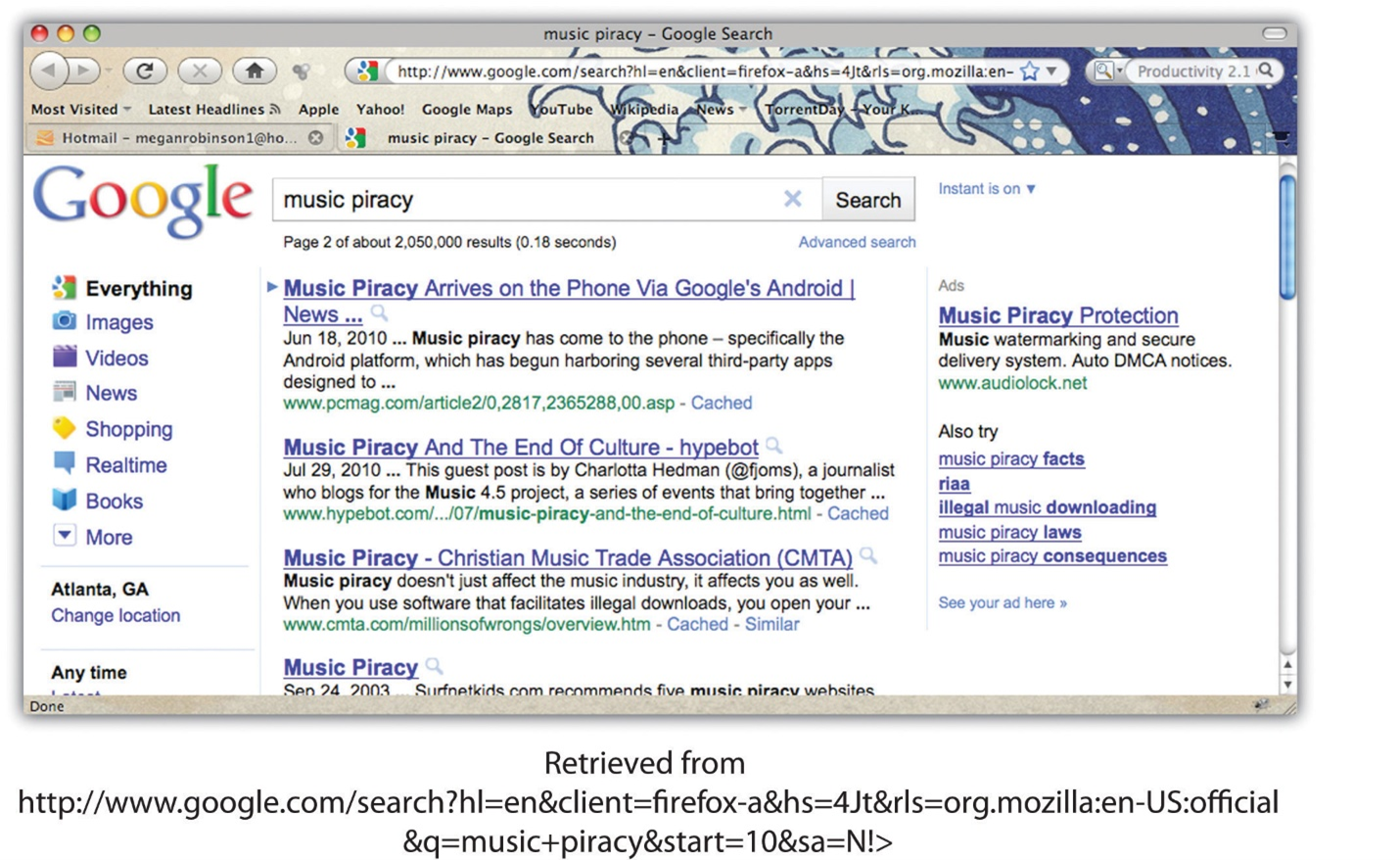
Not all the results online search engines return will be useful or reliable. Give careful consideration to the reliability of an online source before selecting a topic based on it. Remember that factual information can be verified in other sources, both online and in print. If you have doubts about any information you find, either do not use it or identify it as potentially unreliable.
The results from the student’s search included websites from university publications, personal blogs, online news sources, and lots of legal cases sponsored by the recording industry. Reading legal jargon made the student uncomfortable with the results, so they decided to look further. Reviewing their map, the student realized that they were more interested in consumer aspects of mass media, so they refocused their search to media technology and the sometimes confusing array of expensive products that fill electronics stores. Now, the student considers a paper topic on the products that have fed the mass media boom in everyday lives.
Exercise 2.4
In Exercise 2.2, you chose a possible topic and explored it by answering questions about it using the 5WH questions. However, this topic may still be too broad. Here, choose and complete one of the prewriting strategies to narrow the focus. Use either brainstorming, idea mapping, or searching the Internet.
Please share with a classmate and compare your answers. Share what you found and what interests you about the possible topic(s).
Prewriting strategies are a vital first step in the writing process. First, they help you first choose a broad topic and then they help you narrow the focus of the topic to a more specific idea. An effective topic ensures that you are ready for the next step.
Tip
Topic Checklist
Developing a Good Topic
The following checklist can help you decide if your narrowed topic is a good topic for your assignment.
- Am I interested in this topic?
- Would my audience be interested?
- Do I have prior knowledge or experience with this topic? If so, would I be comfortable exploring this topic and sharing my experiences?
- Do I want to learn more about this topic?
- Is this topic specific?
- Does it fit the length of the assignment?
With your narrowed focus in mind, answer the bulleted questions in the checklist for developing a good topic. If you can answer “yes” to all the questions, write your topic on the line. If you answer “no” to any of the questions, think about another topic or adjust the one you have and try the prewriting strategies again.
Key Takeaways
- All writers rely on steps and strategies to begin the writing process.
- The steps in the writing process are prewriting, outlining, writing a rough draft, revising, and editing.
- Prewriting is the transfer of ideas from abstract thoughts into words, phrases, and sentences on paper.
- A good topic interests the writer, appeals to the audience, and fits the purpose of the assignment.
- Writers often choose a general topic first and then narrow the focus to a more specific topic.
Outlining the structure of Ideas
After prewriting, is the outlining and structure of ideas stage. This is when you begin implementing all the ideas that you generated in the prewriting stage. The goal of this stage is to get the ideas out of your head and onto your paper in an organized manner. The outline and structure can change once you begin the writing the rough draft stage. To see how to set up an outline, click here Outlining.
Drafting
Next, you will write your rough draft. The writing of the rough draft occurs after you have a focus and enough information to support that focus. Drafting involves making choices about how much information to offer and what information to put where. Your outline will be a guide, but you may find that you need to revise the order once you begin drafting.
Consider the following points as you draft:
- Is there enough information to provide evidence for your assertions? If not, circle back to gathering information.
- Is there a basic idea that needs to be offered first so that readers understand subsequent ideas?
- Are there related ideas that logically should be grouped together?
- Are there some ideas that are more important than others and, if so, what is the best place in the writing to emphasize those ideas?
- Are there logical linkages between ideas, so readers don’t get lost moving from one idea to the next?
Drafting consists of building the paragraphs of your writing and linking them together. And, remember, your draft you create at this point is not your final draft. There are additional steps of the writing process to consider before you are ready to submit your work
Revising
Many students often try to lump revising and editing into one, but they are really two separate activities. Revising is about your content while editing is about sentence-level issues and typos. It’s important to remember to allow yourself time to complete both parts of this process carefully. Revision is about seeing your writing again. Revising is an important step in the writing process because it enables you to look at your writing more objectively, from a reader’s view. Set your writing aside for a time. Then go back to it and work from big to small as you ask and answer revising questions.
Basic Big Revision Questions—Ask These First:
- Are there places that are not clear?
- Are there places that need more information?
- Are there places that need less information, because the information seems to diverge too much from your main point?
- Does some of the information need to bere-ordered in order to make sense to a reader who may not have much background on this topic?
As you see, these basic revision questions concern themselves with the amount, clarity, and order of information. That’s what the revision process is all about—making sure that your concepts and supporting information are presented in the clearest, most logical way for most readers to understand.
Once you deal with the big things (amount and order of information), then you can move to the small things—the language, grammar, spelling, and punctuation.
Editing
Once you have your content the way you want it and have completed your revisions, it’s time to think about editing your paper. When you edit, you are looking for issues with sentence structure, spelling, punctuation, capitalization, etc. And, when you edit, it’s important to realize that it’s difficult to catch all of these errors in one editing pass. A thorough editing process is one that involves several editing passes. Research on student writing indicates that most of the errors in college essays are related to careless editing. With that in mind, it’s important to take steps to ensure you are engaging in a good editing process.
Questions to Consider When You Edit
- Is the language clear and easy to read and understand? Are difficult terms defined?
- Is the sentence structureclear and easy to understand?
- Are the sentences grammatically correct?
- Have I proofread and checked for typos and misspellings?
- What errors might my spell checker and grammar checker have missed?
- Once you have gathered some feedback, you revise your essay according to that feedback. Remember that revising focuses on making larger changes to your essay to make sure you are expressing your ideas as clearly as possible. Next you begin editing. Editing is like revising, because you are changing your work from the original draft, but you are focused on small scale changes, like grammar, mechanics, spelling, punctuation, and formatting.
The final step of the writing process is submitting your work. This is when you submit your final paper for grading and share your ideas with the rest of your professor and peers.
Key Takeaways
-
Outlining and Structuring Ideas
-
Happens after prewriting.
-
Organizes ideas generated during prewriting into a logical order.
-
Provides a roadmap for drafting but can change later.
-
-
Drafting
-
Begins after you have a clear focus and supporting information.
-
Involves deciding how much information to include and its placement.
-
Ensures logical groupings and order of ideas.
-
Creates the rough draft, not the final version.
-
-
Revising
-
Focuses on content (big picture changes, not grammar).
-
Allows you to view your work objectively, from the reader’s perspective.
-
-
-
Start with big issues (clarity, amount, and order of information) before moving to smaller issues.
-
-
Editing
-
Focuses on sentence-level issues such as grammar, punctuation, spelling, and typos.
-
Requires multiple passes for accuracy.
-
Common errors result from careless editing.
-
Attributions
8.1: Apply Prewriting Models, is shared under a CC BY-NC-SA 3.0 license.
“The Writing Process” published on OER Commons by Institute for the Study of Knowledge Management in Education, is licensed under CC BY 4.0
English 101: Journey Into Open by Christine Jones is licensed under a CC BY-NC-SA 4.0,
Media Attributions
- Photo of Woman Writing © Soundtrap
- Ch. 2 Photo of Woman on Laptop © expresswriters
- Freewriting Example is licensed under a CC BY-NC-SA (Attribution NonCommercial ShareAlike) license
- Asking Questions Image © Mohamed Hassan is licensed under a CC0 (Creative Commons Zero) license
- Ch. 2 5WH Questions is licensed under a CC BY-NC-SA (Attribution NonCommercial ShareAlike) license
- Ch. 2 Brainstorming List is licensed under a CC BY-NC-SA (Attribution NonCommercial ShareAlike) license
- Ch. 2 Idea Mapping is licensed under a CC BY-NC-SA (Attribution NonCommercial ShareAlike) license
- Ch. 2 Google Search Image is licensed under a CC BY-NC-SA (Attribution NonCommercial ShareAlike) license
